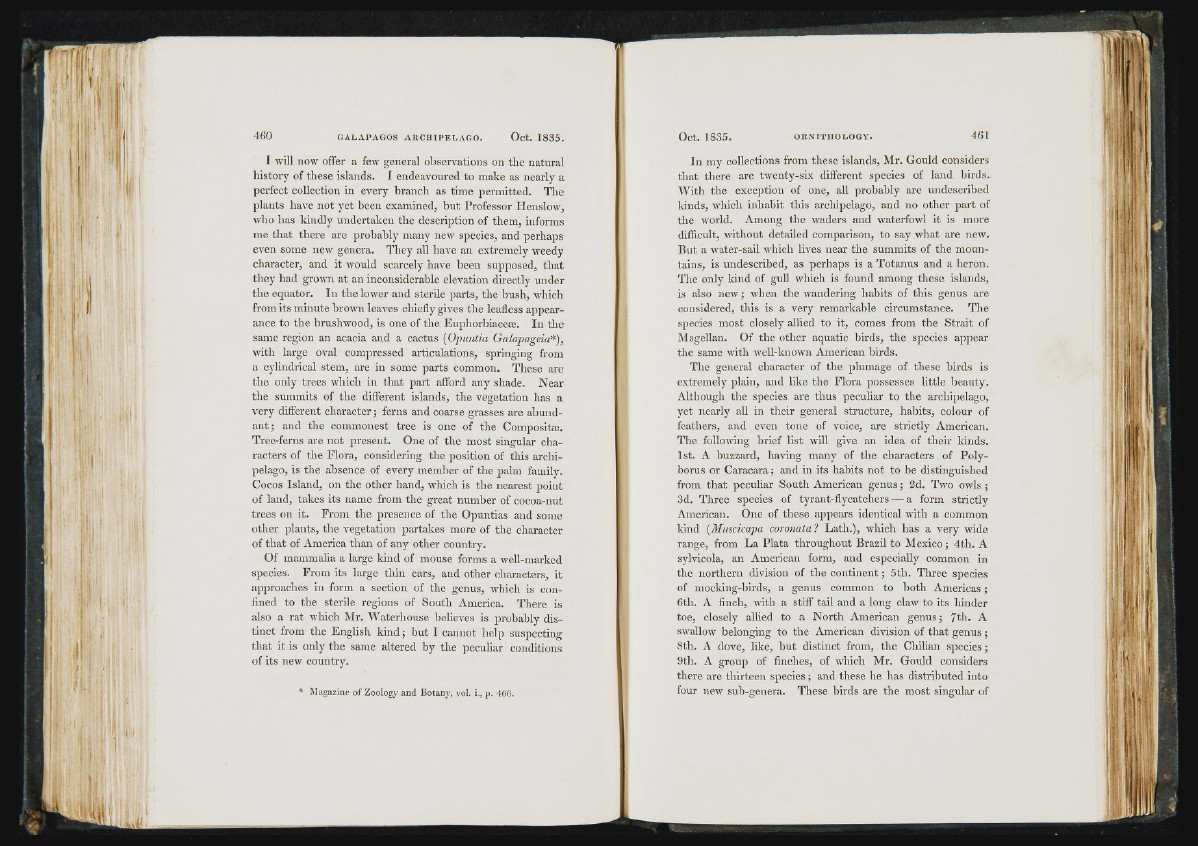
I will now offer a few general observations on the natural
history of these islands. I endeavoured to make as nearly a
perfect collection in every branch as time permitted. The
plants have not yet been examined, but Professor Henslow,
who has kindly undertaken the description of them, informs
me that there are probably many new species, and perhaps
even some new genera. They all have an extremely weedy
character, and it would scarcely have been supposed, that
they had grown at an inconsiderable elevation directly under
the equator. In the lower and sterile parts, the bush, which
from its minute brown leaves chiefly gives the leafless appearance
to the brushwood, is one of the EuphorbiacCcC. In the
same region an acacia and a cactus [Opuntia Galapageia*),
with large oval compressed articulations, springing from
a cylindrical stem, are in some parts common. These are
the only trees which in that part afford any shade. Near
the summits of the different islands, the vegetation has a
very different character; ferns and coarse grasses are abundant;
and the commonest tree is one of the Compositie.
Tree-ferns are not present. One of the most singular characters
of the Flora, considering the position of this archipelago,
is the absence of every member of the palm family.
Cocos Island, on the otlier hand, which is the nearest point
of land, takes its name from the great number of cocoa-nut
trees on it. From the presence of the Opuntias and some
other plants, the vegetation partakes more of the character
of that of America than of any other countiy.
Of mammalia a large kind of mouse forms a well-marked
species. From its large thin ears, and other characters, it
approaches in form a section of the genus, which is confined
to the sterile regions of South America. There is
also a rat which Mr. Waterhouse believes is probably distinct
from the English kind; but I cannot help suspecting
that it is only the same altered by the peculiar conditions
of its new country.
* M ag a z in e o f Z o o lo g y a n d B o ta n y , vol. i., p . 4G6.
In my collections from these islands, Mr. Gould considers
that there are twenty-six different species of land birds.
With the exception of one, all probably are undescribed
kinds, which inhabit this archipelago, and no other part of
the world. Among the waders and waterfowl it is more
difficult, without detailed comparison, to say what are new.
But a water-sail which lives near the summits of the mountains,
is undescribed, as perhaps is a Totanus and a heron.
The only kind of gull which is found among these islands,
is also new; when the wandering habits of this genus are
considered, this is a very remarkable circumstance. The
species most close!)' allied to it, comes from the Strait of
Magellan. Of the other aquatic birds, the species appear
the same with well-known American birds.
The general character of the plumage of these birds is
extremely plain, and like the Flora possesses little beauty.
Although the species are thus peculiar to the archipelago,
yet nearly all in their general structure, habits, colour of
feathers, and even tone of voice, are strictly American.
The following brief list will give an idea of their kinds.
1st. A buzzard, having many of the characters of Polyborus
or Caracara; and in its habits not to be distinguished
from that peculiar South American genus; 2d. Two owls ;
3d. Three species of tyrant-flycatchers — a form strictly
American. One of these appears identical with a common
kind (Muscicapa coronata? Lath.), which has a very wide
range, from La Plata throughout Brazil to Mexico; 4th. A
sylvicola, an American form, and especially common in
the northern division of the continent; Sth. Three species
of mocking-birds, a genus common to both Americas;
6th. A finch, with a stiff tail and a long claw to its hinder
toe, closely allied to a North American genus; 7th. A
swallow belonging to the American division of that genus;
Sth. A dove, like, but distinct from, the Chilian species;
9th. A group of finches, of which Mr. Gould considers
there are thirteen species; and these he has distributed into
four new sub-genera. These birds are the most singular of